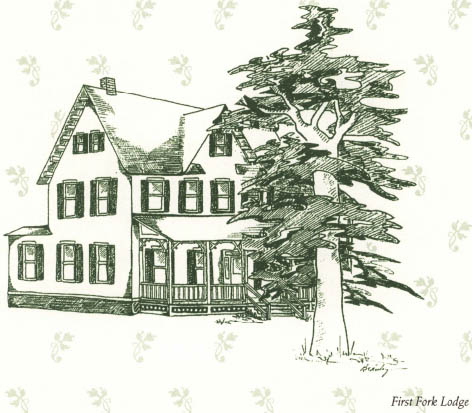

With so much rich history at these restaurants, it’s not surprising that rumors about individuals who were a part of that history linger. The stories might be about a previous owner, a guest, a passerby, or a neighbor. Regardless, each seems to be linked to strange occurrences or visitations from the spirit world. Although locals enjoyed regaling us with stories, we have no personal experiences to tell, other than those of good food and terrific atmosphere.
1 FOUNTAIN AVENUE
CAMBRIDGE SPRINGS, PA 16043
800-964-5173
The birth of Riverside Inn came in 1884, but its conception took place twenty-five years earlier, with the discovery of oil in nearby Titusville. That discovery caused “black gold fever” in the surrounding area. Dr. John H. Gray, a landowner along French Creek, was one of those infected. In early 1860, he was strolling along the bank of the creek with a metal probe when he discovered not oil but a spring. Over the next fifteen years, Gray paid little attention to his discovery—until, that is, rumors began to circulate that laborers who frequently drank from the spring never got sick. After accompanying a patient to Hot Springs, Arkansas, in 1884, Gray noticed the similarity between the water at the two sites in separate states. Upon returning home, he probed again and discovered four more jets of the same “special” spring water, which he used to treat dyspepsia and kidney and liver complaints. According to an old Riverside Inn pamphlet, he found that the “waters, unassisted, affected many cures.” He erected a springhouse and began selling the mineral water at a “nominal price.”
Riverside Inn, built near the springs by W. D. Rider in 1884, was one of the first health spas of its kind. Licensed physicians supervised treatments while guests indulged in Russian, Turkish, sea-salt, and mineral baths. In 1895, the hotel was sold to the William Baird family, who also purchased Gray’s springhouse. At that time, numerous hotels were popping up around Cambridge Springs, the closest town. Thanks to its location a hundred miles from Pittsburgh, Buffalo, and Cleveland and its status as the halfway point on the route between Chicago and New York, Cambridge Springs flourished.
Like all fads, the mineral-water craze eventually died out. But during the fifty years of the Bairds’ ownership, Riverside Inn developed into a complete resort. It was the last of Cambridge Springs’ grand hotels.
Since purchasing the property in 1985, Michael and Marie Halliday have worked to re-create Riverside Inn’s Victorian aura. Stepping into the lobby, we immediately noticed the original tile floor and the bellhops’ bench. Today, it’s cushioned, but back then, the bellhops sat straight and tall on the wooden bench waiting for someone to ring. Reminders of past glory adorn the lobby, from the key cubbyholes to the vintage cash registers. Along the adjoining hallway are historic pictures of the inn and other memorabilia. The most intriguing items are the stoneware jugs, which were placed outside bedroom doors by guests. It was the duty of the bellhops to collect them, walk the quarter-mile or so to the springs, fill them, and return them to the guests. And that was at six o’clock in the morning! Interestingly enough, Mrs. Halliday explained that some guests feel there are also relics that go unseen—namely, the spirits of two men and a woman, all in Victorian attire, who watch over the resurgence of Riverside Inn.
The multiple dining rooms are frequently in use for private parties, while the Victorian Room functions as a popular dinner theater. The Concord Room serves as the main dining area. On the lunch menu, you’ll find familiar favorites such as a Club Sandwich, a Chef’s Salad, and a Tuna Melt, as well as daily specials. The dinner menu includes Beef, Chicken, Veal, and Seafood choices. We found the food very good and reasonably priced. Combine all that with fabulous service and you have a terrific dining experience! But make other dining plans for the winter, because Riverside Inn is closed from late December until mid-April.

 ARTICHOKE FROMAGE
ARTICHOKE FROMAGE 
6 canned artichokes, chopped
1 cup cream
2 teaspoons basil
1 teaspoon garlic, minced
¼ teaspoon salt
2 tablespoons Parmesan or Romano cheese
toast points
Combine all ingredients except toast points in a saucepan and simmer until thickened. Place in a baking dish under broiler until golden brown. Serve with toast points. Serves 2.

 OLD-FASHIONED COUNTRY TOMATO SOUP
OLD-FASHIONED COUNTRY TOMATO SOUP 
1 tablespoon butter
½ cup onions, diced
½ cup carrots, diced
½ cup celery, diced
2 cups fresh tomatoes, diced
1 tablespoon basil
1 tablespoon garlic, chopped
2 cups tomato juice
1 cup chicken stock
1 cup cream
¼ cup cornstarch
¼ cup water
salt and pepper to taste
In a 3- to 4-quart pot, melt butter and sauté onions, carrots, celery, and tomatoes until lightly browned. Stir in basil and garlic. Add tomato juice and chicken stock. Cook for 15 minutes. Add cream. Thicken with equal parts cornstarch and water. Add salt and pepper. Serves 6 to 8.

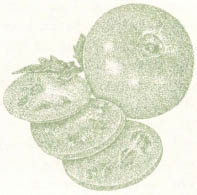
1325 OLD US 30
CASHTOWN, PA 17301
717-334-9722
Actor Sam Elliott, who starred in the epic film Gettysburg, was a guest here during the making of the movie. Many of the scenes were actually filmed at this location. Dirt was hauled in to cover the parking lot and the road out front to create a landscape that echoed the authenticity of the inn.
Built in 1797 as the first stagecoach stop west of Gettysburg, the Old Hotel, as the inn was originally known, was a haven for weary travelers. Its name was changed as a result of how the owner did business. During that era, goods and services were frequently paid for by barter. However, the gentleman who ran this inn accepted only cash. Since the surrounding town had no name, travelers up and down the pike began referring to the area as “Cashtown.” The name stuck, and, eventually, the Old Hotel’s name was changed to Cashtown Inn.
Prior to the Battle of Gettysburg, the hotel served as the headquarters of Confederate general A. P. Hill. Civil War art and memorabilia decorate the dining room, the sitting room, and the adjacent tavern room. Glass-topped tables with jacquard cotton tablecloths provide comfortable seating for about twenty-five guests. Under the glass are maps of the Gettysburg campaign for diners to peruse while waiting to be served. The brick walls, the original fireplace, and the wide-plank bar at one end of the room add to the coziness of this casual dining area. At the back of the inn is a more formal dining room with linen tablecloths and napkins. Civil War music plays quietly in the background while guests enjoy classic country cuisine. On the front wall is an impressive mural of the inn, sketched and painted from memory by Gettysburg postmaster John Meckley, a relative of former owner Bud Buckley.
During our travels, we met a family from Boston who highly recommended Cashtown Inn’s Herbal Mushroom and Cheese Casserole and its Soup Trio. We didn’t have the Soup Trio, but we did try the chilled Pear Soup and the creamy Tomato Basil Soup. Both were wonderful and would be delicious accompaniments to a salad, topped with a choice of the inn’s homemade dressings. The house dressing is Creamy White Chablis. For dieters, a fat-free French-Style Honey Pineapple is available. We also thought the Maple Dijon sounded interesting. No trace of Karen’s Crab Imperial, served on foccacia bread, was left at the end of the meal; her empty plate spoke for itself.
While we were eating, we noticed a photograph of Jason Hoover, one of the innkeepers. Behind him in the picture was an aberration that looked vaguely like a spinal x-ray. The note on the back of the picture, from a 1999 guest, suggested that maybe it was something supernatural. She wasn’t the first to capture such an image; similar pictures hang on the walls as well. It has been suggested that the spirit of a Civil War soldier may be at work. Regardless of whom the presence represents, the guest who sent the picture of Jason mentioned unusual experiences during her visit. Ours was very straightforward, but if you go, maybe the ghost will visit you, too.

 BAKED BRIE WITH FRUIT
BAKED BRIE WITH FRUIT 
8-ounce wheel Brie cheese
¼ cup nuts (slivered almonds, pecans, or walnuts)
6 to 8 slices fresh fruit (strawberries, peaches, cantaloupe, or other melon)
1 sheet puff pastry
1 egg
1 cup milk
½ cup honey
Preheat oven to 350 degrees. Slice Brie horizontally and place nuts and fruit in the middle to make a Brie sandwich. Roll puff pastry to  -inch thickness and wrap around cheese. Combine egg and milk to make an egg wash; seal pastry by brushing with egg wash. Bake about 10 minutes until pastry is golden brown. Remove from oven, drizzle with honey, and serve immediately. Serves 6 to 8 as an appetizer.
-inch thickness and wrap around cheese. Combine egg and milk to make an egg wash; seal pastry by brushing with egg wash. Bake about 10 minutes until pastry is golden brown. Remove from oven, drizzle with honey, and serve immediately. Serves 6 to 8 as an appetizer.

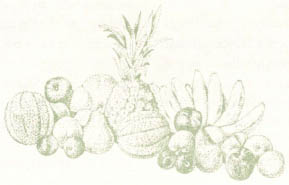
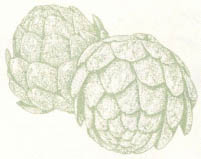
 ARTICHOKE DIP CYNTHIA
ARTICHOKE DIP CYNTHIA 
10-ounce can artichoke hearts
2 3-ounce packages cream cheese
¼ cup mayonnaise
2 tablespoons chives
4 tablespoons salsa
½ cup cheddar cheese, grated
foccacia toast points
Preheat oven to 350 degrees. Drain and quarter the artichoke hearts. Combine next 5 ingredients thoroughly, then stir in artichokes. Place in a baking dish and bake 15 to 20 minutes until warm and bubbly. Serve with foccacia toast points for dipping. Serves 6 to 8.
Note: This recipe is named after chef Keeney’s wife.

38 NORTH UNION STREET
MIDDLETOWN, PA 17057
717-944-5373
Definitely a grand old lady, this home was designed in the post-Civil War era, and its brownstone exterior and intricate, fanciful details reflect the optimism of its time. Extravagantly built in 1888 by Charles Raymond, the house went to Middletown National Bank twelve years later to pay off Mr. Raymond’s creditors.
In 1898, Redsecker Young purchased the dwelling for the then-exorbitant sum of sixty-six hundred dollars! Four years later, the home passed into the hands of the locally prominent Simon Cameron Young, who eventually bequeathed it to his two daughters, Emman and Eliza. The house gradually deteriorated, but its beauty and craftsmanship were still evident when Herman and Sara Baum purchased it in 1949 and began their twenty-year occupancy. Alfred Pellagrini rescued the home in 1970, purchasing it just one day before it was scheduled to be demolished.
As was customary with Victorian architecture, the roof is peaked and gabled and has dormers and many gingerbread adornments. Most of the exterior windows are crowned with stained-glass transoms. An intricate stained-glass window signed by a Philadelphia artist decorates the semicircular landing on the staircase leading from the entry area. Other details include ball-and-spindle grilles, carved wainscoting, and inlaid ceramic floors. In the dining room to the left of the hall, the inlaid wooden floor is original, as is the richly colored wallpaper. The fireplaces have intricate woodwork, cubbyholes, and beveled mirrors. One of the home’s unique features is what appear to be floor-to-ceiling windows in the dining room. Actually, they are doors that slide into the ceiling, allowing passage to the porch.
Enormous pocket doors separate the individual rooms from the rest of the house. Those that divide the original dining room from the parlor area are particularly beautiful because of the stained-glass inserts decorating the top halves of the doors. Pellagrini once heard footsteps behind the doors and called police about an intruder. But when they searched the mansion, they found no one. Research into the matter suggested that the footsteps may have belonged to the ghost of Emman Young, who is said to pace the floor mourning the young man she loved but was not allowed to marry.
In our window seat, tucked away in a cozy turret room off the parlor, we wondered if Emman might have sat in the same location, wistfully watching for her young man to walk by. We enjoyed the view of the nearby downtown as we lunched on Garlic Soup, salad, and the pasta special of the day, a Cinnamon-Basil Linguine made on the premises. Wanting to linger, we managed to find room for dessert. The Chocolate Louise was yummy, and the Tiramisu, which our waitress, Carolyn, had made, was declared by Karen the best she’d ever eaten.
 STRACCIATELLA SOUP
STRACCIATELLA SOUP 
4 cups fresh chicken broth
4 eggs
4 heaping tablespoons grated Parmesan or Romano cheese
pinch of nutmeg
pinch of salt
pinch of pepper
2 tablespoons fresh spinach, chopped
Heat broth to a boil. In a bowl, beat eggs, cheese, nutmeg, salt, and pepper. Add to stock. Remove from heat. Add spinach, stirring gently. Place in serving bowls and sprinkle additional grated cheese over top. Serves 4 to 6.

 STEAK DIANE
STEAK DIANE 
2 tablespoons butter
1 teaspoon Tabasco sauce
2 tablespoons Worcestershire sauce
2 tablespoons fresh chives, minced
2 teaspoons lemon juice
salt and pepper to taste
2 3-inch-thick filets mignons, butterflied
6 tablespoons brandy
2 tablespoons cream sherry
Melt butter in a small sauté pan over medium-high heat, being careful not to burn. Add Tabasco, Worcestershire, chives, lemon juice, and salt and pepper. Place steaks in pan and sear on 1 side. Turn steaks. Blend brandy and sherry in a flambé cup and heat until mixture ignites; be careful. Pour flaming liquid over steaks, spooning sauce around meat until flame extinguishes. Continue cooking until meat reaches desired doneness. Serves 2.

 FISH IN LEMON PEPPER BRANDY SAUCE
FISH IN LEMON PEPPER BRANDY SAUCE 
¼ cup olive oil
½ cup butter or margarine
½ cup dry white wine
1 teaspoon salt
black pepper, ground coarse
2 tablespoons plus ¾ teaspoon lemon juice
4 8-ounce fish fillets of your choice
¼ cup brandy
Combine first 6 ingredients in a sauté pan. Add fish and cook each side on medium heat for about 3 minutes, depending on thickness. Flambé with brandy to finish. Squeeze additional lemon juice over fish just prior to serving, if desired. Serves 4.

PA 872
AUSTIN, PA 16720
814-647-8644
If you’re in the mood for a good story in addition to a delicious meal, both served up in a unique atmosphere, then First Fork Lodge is the place for you. During March, April, September, and October and around Christmas and New Year’s as well, the Krafft family stages a dinner theater that tells the story of the Costellos, the original owners of First Fork Lodge. The four-course dinner consists of the soup du jour, possibly a Spinach Salad, entrées of Seafood Casserole and sliced Roast Beef, served with vegetables, and Bread Pudding for dessert. The story is full of intrigue and marital discord.
The house was built in 1883 by the owners of what was reported to be the largest tanning factory for shoe leather in the world at that time. Mr. Costello also owned the company store and the houses in which his workers lived. His brother owned the rest of the town. Since the Costellos ran the town, it’s not surprising to learn that they built a jail cell in the basement of the family home. Anybody who broke the law was thrown into their personal brig until the next time an official lawman came to this rural area. Due to family problems that eventually led to the divorce of Mr. and Mrs. Costello, the family sold the home during the early 1900s.
In 1925, the family living in the house lost their daughter to measles. Her spirit has been reported wandering through First Fork Lodge. Many guests have mentioned seeing or hearing the twelve-year-old. Objects left in one room are found in another, and items are knocked over when no one is around. Once, when Linda Krafft was on the sofa taking a nap, a fire was laid in the wood-burning stove. Jack, her husband, thought Linda had done it; Linda thanked Jack for such a nice fire.
Focused on the myriad attention-drawing collectibles throughout the house, many guests never experience the ghost. Each room is filled with antiques and sundry items from Linda’s many collections. Mantelpieces from Linda’s childhood home, unexpectedly discovered at a local antique shop, can be found in the living room and the upstairs hallway. Every room houses a collection of hunting prizes such as deer heads, a fox, and other local game. Each bedroom at First Fork has a decor befitting its theme. You might find yourself deep in the forest in a tree-house bed surrounded by lush silk greenery out of which various stuffed animals peer.
The day we visited, Steve Brooks, a First Fork employee, entertained us with abundant stories as we toured the home. First Fork houses hunters and fisherman, as well as those just wanting to get away from it all. We recommend that you try the dinner theater, so as to get the full history of the lodge. Regardless, reservations are a must. The menu is predetermined but is sure to be delicious.

 BREAD PUDDING WITH CARAMEL SAUCE
BREAD PUDDING WITH CARAMEL SAUCE 
Bread Pudding
2 cups milk
¼ cup margarine
½ cup sugar
½ teaspoon nutmeg
1 teaspoon cinnamon
¼ teaspoon salt
2 eggs, beaten
6 cups homemade bread, cubed
½ cup raisins
Preheat oven to 350 degrees. Heat milk and margarine in a 2-quart saucepan over medium heat until margarine is melted. Set aside. Mix sugar, nutmeg, cinnamon, salt, and eggs in a large bowl. Stir in bread cubes and raisins. Pour milk over bread mixture, then transfer entire mixture to an ungreased 1½-quart casserole. Place casserole into a 13-by-9-inch pan. Pour boiling water into the pan until water is 1 inch deep. Bake 40 to 45 minutes. Serves 6 to 8.
Caramel Sauce
½ cup butter or margarine
1¾ cups brown sugar
2 tablespoons com syrup
½ cup whipping cream
Melt butter in a medium saucepan over medium heat. Add sugar and continue cooking until it dissolves. Stir in corn syrup and cream. Continue cooking and stirring as mixture thickens; do not boil. When thickened, pour over top of Bread Pudding just before serving. Yields enough sauce for 1 batch of Bread Pudding.

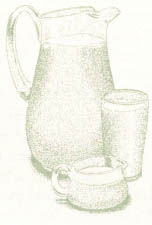
2 28-ounce cans diced peaches
2 8-ounce packages cream cheese, softened
¼ cup walnuts, crushed
¼ teaspoon nutmeg
1½ teaspoons cinnamon, divided
2 teaspoons vanilla, divided
1 loaf Italian bread, cut into 1½-inch slices
¼ cup brown sugar
1½ tablespoons cornstarch
1½ tablespoons water
2 cups milk
6 eggs
1 tablespoon sugar
whipped cream
Drain 1 can of peaches, reserving juice. In a large mixing bowl, combine ½ can of drained peaches with cream cheese, mashing the peaches into the cheese. Add walnuts, nutmeg, ½ teaspoon of the cinnamon, and 1 teaspoon of the vanilla. Mix well with a fork and set aside. Starting at the top of the bread slices, cut a pocket down into the bread about ¾ inch from each side. Do not slice all the way to the bottom. Stuff the pocket with 2 to 3 tablespoons of cream cheese mixture. Place the remaining 1½ cans of peaches, with juice from both cans, into a large saucepan. Warm slowly, adding brown sugar. In a small bowl, stir cornstarch into water until dissolved. Stir cornstarch mixture into peaches in saucepan. Heat until bubbly, stirring frequently. Continue to heat until mixture is thickened to a syrupy consistency. If necessary, add additional cornstarch mixture 1 teaspoon at a time until thick. Reduce heat to warm. In a medium-sized bowl, mix milk, eggs, sugar, remaining 1 teaspoon cinnamon, and remaining 1 teaspoon vanilla. Roll stuffed bread in mixture, then place it in a heated skillet or on a griddle. Cook until it turns golden brown. Serve topped with peach sauce and whipped cream. Serves 6 to 8.

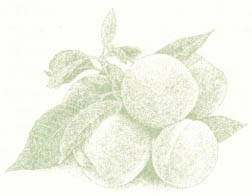
230 MERCER STREET
HARMONY, PA 16037
724-452-5124
“Agreement in feeling, approach, action, or disposition” is the dictionary definition of harmony. Such agreeable feelings were the ideal of the German settlers, known as Harmonites, who founded the community of Harmony in 1804. Their five thousand acres of land north of Pittsburgh became one of America’s most successful examples of communal living. Today, Harmony is preserved much as it was during its heyday. Most of the buildings in the three-block-by-four-block community are from the era of the town’s founding; plaques indicate their original owners or purpose. Harmony residents are proud of the heritage of their community, and rightly so.
In 1856, Harmony was to become a northern railroad terminus. In anticipation of this, Pittsburgh and New Castle railroad magnate Austin Pearce built a mansion in Harmony for his summer home. The scale and magnificence of the Italianate home reflected the optimism of both Pearce and much of the country. Although the original Harmonites had died or moved to new settlements at New Harmony, Indiana, or Economy, Pennsylvania, their descendants felt that the home’s extravagance bordered on being sinful.
When Pearce’s grand expectations were not realized, he sold the home to the Ziegler family, who had purchased the town from the Harmonites. The home was converted into a hotel and saloon, becoming one of the earliest licensed establishments in Butler County. From that time until now, a restaurant has been in continuous operation here.
The atmosphere today is that of an upscale hunting lodge, complete with a rack of antlers above the fireplace in one of the dining rooms. Vintage pictures and memorabilia line the walls. The large arched windows and mammoth arched doors were part of the original structure. Horsehair is visible protruding from the old mortar. The original tile floor is still intact in the bar area.
A violent murder once took place on the premises. Although accounts vary as to whether it was a shooting or a stabbing, locals feel that the murder could be the source of the friendly presence at the inn. The day we were there, the clientele urged owner Carl Beers to tell us the story. He said that he and others have experienced unexplained air movement and electrical impulses, that some have felt a warm presence, that objects have been misplaced and found in unusual places, and that unexplained images have been sighted. Psychics have been invited in to document what they say is a presence that watches over the inn and its customers.
Regardless of whether you experience the presence (and we didn’t), you’re sure to experience great food in ample quantity. Sandwiches dominate the lunch menu, while the dinner menu boasts a full range of entrées, from Pasta to Chicken to Beef to Sandwiches. While Debbie thoroughly enjoyed her Smoked Turkey Reuben, Karen tried the Smoked Beef Dip Sandwich, made from brisket smoked at the inn, then slow-roasted overnight. Mr. Beers offered us the recipe, but we felt it was something that guests ought to go and try at the inn itself.

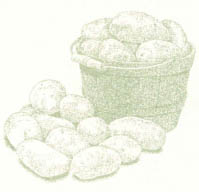
 COMANCHERO FRIES
COMANCHERO FRIES 
1 large potato, skin on
¼ cup Monterey Jack cheese, shredded
½ cup green chili sauce or regular salsa, heated
½ cup retried beans, heated
½ cup (or to taste) jalapeño peppers, chopped
¼ cup bacon bits
¼ cup cheddar cheese, shredded
2 tablespoons ranch dressing
Hand-cut potato into fries and place in fryer. Combine Monterey Jack, green chili sauce, and retried beans, mixing well. When fries are golden brown, remove from oil and drain. Top with Monterey Jack mixture, then sprinkle jalapeños, bacon, and cheddar over top and drizzle with dressing. If desired, commercially prepared waffle fries can be substituted for fresh potato. Serves 1 to 2.

 SMOKED TURKEY REUBEN
SMOKED TURKEY REUBEN 
1 tablespoon butter, melted
2 slices marbled rye bread
2 tablespoons Thousand Island dressing
1 slice Swiss cheese
5 ounces smoked turkey breast, sliced
 cup coleslaw
cup coleslaw
Butter 1 side of each slice of bread. Place on a grill or in a skillet, buttered side down. When bread is browned, spread dressing on unbrowned side of 1 slice. Place cheese on top of turkey and put under broiler until cheese melts. Place turkey and cheese on the other slice of bread and top with coleslaw and then the other slice of bread. Yields 1 sandwich.

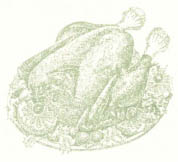
401 SOUTH JUNIATA STREET
HOLLIDAYSBURG, PA 16648
814-695-9924
Pioneer Adam Holliday survived Indian attacks and the turmoil of the American Revolution before starting his homestead on the banks of the Juniata River. By 1796, he prospered so that he began laying out a town in the valley. When Holliday’s son, John, opened a tavern in 1814, there were still just a few homes and farms in the area. Four years later, when the Huntingdon, Cambria, and Indiana Turnpike was completed, the tavern and town became a popular stopping place for travelers.
The Pennsylvania Canal, finished in 1832, opened Hollidaysburg to trade with Philadelphia and other points east. Two years later, the Allegheny Portage Railroad joined the canal with the growing American West. Hollidaysburg became a vital link in the development of industrial areas such as Johnstown and Pittsburgh. To accommodate the growing number of travelers, John Dougherty built the U.S. Hotel in 1835 to provide food, lodging, spirits, and entertainment for man and beast (or so the gaudy signs of the times proclaimed). By 1837, the Juniata Street basin was a hub for shipping and trading warehouses.
The town’s status as a transportation center lasted only about twenty years, until the Pennsylvania Railroad’s main line caused Altoona to emerge as the new center of activity. The U.S. Hotel survived that downturn, only to be destroyed by fire in 1871. Several years later, a German immigrant rebuilt the hotel and established a brewery on the premises. In 1905, a barroom was added to the brick structure. It continues to function as such today. The original tile floor is still in place. If you know where to look, you can find the name Sarah Smith written on one of the small tiles. Actor John Wayne once bellied up to the bar in this room, where many relics of the hotel’s past are still housed. The hand-carved mahogany backbar is impressive in its size and workmanship. On the walls are old pictures of the town and the hotel, as well as beveled, silvered mirrors and leaded stained-glass windows. The brass foot rail is still there, too, under which still flows a running-water spittoon.
Alongside the tavern are the dining rooms, appointed in burgundy and hunter green. The smaller of the front rooms was once the lobby and later served as a poolroom; an old abacus used for keeping score still hangs on the wall. Across the hall is the largest of the dining rooms, which was once the waiting area. Ladies waited in the front and men in the back, from where they had direct access to the bar.
The dining room where we ate has always been used as such. We enjoyed the Filet Mignon Sandwich, the Juniata Street Turkey and Cheddar Croissant, and the Onion Rings. As we considered dessert, we heard a story about an unusual visitor. One evening after dining, a guest came to owner Karen Yoder and told her that she definitely felt a presence in the room. What seemed to be a friendly female presence visited again late one evening as Karen and her son painted the room. Occasionally, she has been felt in the cellar or seen upstairs.
As usual, we experienced nothing but good food in a very pleasing atmosphere. We’ll certainly come back to try other tempting entrées, such as the Rigatoni with Wild Mushrooms and Sausage, the Blackened Blue Chicken, and the Veal Santa Monica.

 MIXED GRILL
MIXED GRILL 
2 4-ounce beef tenderloins
2 5-ounce chicken breasts
2 teaspoons garlic, chopped
2 tablespoons butter
6 shrimp, peeled and deveined
1 cup honey
2 tablespoons whole-grain mustard
½ cup demi-glace or brown sauce
fresh herbs for garnish
Place tenderloins and chicken on a grill and cook to desired doneness. While they are grilling, place garlic, butter, and shrimp in a sauté pan and cook until done. Combine honey and mustard in a small bowl.
To serve, place demi-glace in a small circle on 2 plates and top each circle with a tenderloin. Place chicken breasts beside tenderloins and top with Honey Mustard Sauce. Place 3 garlic shrimp between each tenderloin and breast. Garnish with fresh herbs and serve. Serves 2.
 DRUNKEN MUSHROOMS
DRUNKEN MUSHROOMS 
4 tablespoons butter, divided
3 cups fresh mushrooms
½ cup brandy
1½ cups heavy cream
salt and pepper to taste
2 teaspoons parsley, chopped
8 slices French bread, sliced on the bias
Melt 2 tablespoons of the butter in a sauté pan. Add mushrooms and sauté for 30 seconds. Add brandy and flame over burner. Add cream, remaining butter, salt and pepper, and parsley and simmer over a low flame until mixture begins to thicken. Toast bread under the broiler. Arrange bread on a plate in the shape of a cross. Once sauce has thickened, pour over toast points. Serves 2.

 CHICKEN FROMAGE
CHICKEN FROMAGE 
2 8-ounce boneless, skinless chicken breasts
4 slices tomato
4 slices mozzarella
4 slices provolone
parsley for garnish
Split breasts in 2 and grill until done. Remove chicken from grill and top with tomato and cheeses. Broil chicken until cheeses are melted. Garnish with parsley and serve. Serves 2.

4424 OLD EASTON ROAD
DOYLESTOWN, PA 18901
215-230-9999
Sign of the Sorrel Horse was fashioned in the 1920s from a gristmill built in the 1700s. The surrounding area was originally called Dyertown, after John Dyer, who arrived in Philadelphia in 1714, then settled here on twenty-five hundred acres in 1718.
Dyer’s grandson, John Dyer, Jr., kept a diary that provides an account of traveling many miles in August 1777 to Warwick Township to see the Continental Army, “consisting of about 18,000 men.” The Marquis de Lafayette is said to have dined with the Dyers during that time. John Jr. later described the English leaving Philadelphia on June 18, 1778, but he omitted Washington’s arrival near Dyertown two days later. It has been claimed that the Dyers’ mill provided Washington’s men with flour in June 1778 as the army camped on a hill known as Doyltown. John Jr. wrote nothing of this, however, in his usually thorough diary. In fact, the diary is blank from his June 18 entry until March 1779—the biggest lapse of time throughout the entire diary. It is not known what kept him from recording his thoughts during that six-month period, when surely there was much to be noted.
Lafayette is said to have enjoyed his visit with the Dyers so much that his ghost returns each year on the anniversary of the meal. Mr. and Mrs. John Corcoran, the owners of the establishment many years ago, went out of their way to provide hospitality to Lafayette’s restless spirit. The Corcorans set aside a table—complete with a burning candle, a loaf of bread, and a bottle of wine—for their guest from the other world. After the restaurant passed into the hands of Ruth and Charles Kiker, an employee was alone in the inn one evening. Needless to say, he was startled when he heard a low voice call out, “John! John!” The employee swallowed hard and responded, “My name is not John.” The unidentified voice answered, “Oh!” and said no more that evening.
On the night I dined, the only unusual sounds were those of the parakeets and white doves in the birdcages that decorated my little alcove. This intimate setting was just off the Escoffier Room, a lovely dining room with chandeliers reminiscent of Sweden’s Santa Lucia Day. The walls of the Escoffier Room are a bittersweet color that coordinates beautifully with the navy wing chairs and Oriental rugs. The atmosphere is completed by one of the building’s three fireplaces, accessorized with candles and copper wares.
Game is a specialty here. Elk, Caribou, Antelope, Venison, and Wild Boar are prepared seasonally. Eventually, I settled on the New Orleans Barbecue Shrimp, four large prawns in a sweet and tangy glaze. In the mood for seafood, I followed this up with Swordfish and Salmon, served in Whole-Grain Mustard Sauce with a wedge of Blue Cheese Polenta. It was a deliciously light entrée for a hot August evening. Before rejoining Karen, I decided to finish out the meal with the fresh Sorbet. The mango flavor was the perfect ending to a delightful meal.
 COLORADO ELK LOIN IN SWEDISH LINGONBERRY AND CASSIS SAUCE
COLORADO ELK LOIN IN SWEDISH LINGONBERRY AND CASSIS SAUCE 
Bouquet garni
3 sprigs whole thyme, chopped fine
1 celery heart, chopped fine
1 leek casing, chopped fine
2 bay leaves
4-inch-square cheesecloth
9-inch kitchen string
Place thyme, celery heart, leek, and bay leaves in center of cheesecloth. Draw corners together and tie with string.
Elk and veal stock
2 pounds elk bones
2 pounds veal bones
2 carrots, chopped
2 onions, chopped
2 stalks celery, chopped
Preheat oven to 425 degrees. Place elk and veal bones on a roasting tray and roast until they reach a deep caramel color; turn bones periodically. Place bones into a soup pot with 12 cups of cold water and bring to a slow simmer. Continue cooking for 4 hours. Add carrots, onions, celery, and bouquet garni. Cook an additional 30 minutes. Strain mixture through cheesecloth.
Elk loin
1 cup cassis
½ cup lingonberries
30 ounces elk loin
salt and pepper to taste
olive oil
Add cassis to elk and veal stock and reduce mixture to about 2 cups. Add lingonberries and simmer for 2 minutes. Sauce should coat the back of a spoon.
Season elk loin with salt and pepper. Coat an ovenproof pan with olive oil. Heat pan in oven. When oil just begins to smoke, add elk loin and sear at high heat until browned. Finish cooking elk in a 350-degree oven until it reaches desired doneness. Slice into 6 equal portions and serve. Serves 6.

 CHOCOLATE VOLCANO
CHOCOLATE VOLCANO 
5 1-ounce squares semisweet chocolate
1½ 1-ounce squares unsweetened chocolate
14 tablespoons sweet butter
4 eggs
4 egg yolks
1 cups confectioners’ sugar
cups confectioners’ sugar
1 scant cup pastry flour
Pam spray or butter
Melt semisweet chocolate and unsweetened chocolate with butter. Add eggs, yolks, and sugar; mix well. Sift in flour. Spray or grease 4 soufflé dishes. Pour batter into dishes and bake for 10 minutes in a 500-degree oven. Serves 4.

CEDAR CREST AND HAMILTON BOULEVARDS
ALLENTOWN, PA 18103
610-435-1723
Now a National Historic Site, this “publik coach house serving tired and hungry wayfarers” was established in 1756 in the hamlet then called Dorneyville. Built during the French and Indian War, the tavern served as a way station between Philadelphia and the Allegheny Mountains. During that difficult time, a group of Indians is said to have kidnapped and killed several babies from the area, disposing of their bodies by throwing them into various Dorneyville wells. More than 150 years later, an employee of this inn accidentally locked herself in the cellar, located near the inn’s well. As she waited for someone to realize she was there, she was terrified to hear a baby’s scream. Fortunately, such demons of the past have given way to gaiety today. The well now serves as the inn’s wine cellar. The basement, a paneled room, now functions as a tavern, where jazz was being played the night we visited.
Following the French and Indian War, the inn saw its day as a town hall, meeting house, news center, church, and courthouse. It was also the site of a staging field for regular and irregular citizen-soldiers during the American Revolution. Perhaps Dorney’s Tavern, as it was called back then, even hosted a few meetings of the Sons of Liberty, those revolutionary planners.
From regular dinner seating to special events, this stone structure carries on its legacy of congeniality and delicious food. Recently, it hosted a Titanic reenactment dinner, which proved to be a huge success. In doing the research for that event, restaurateur Clifford McDermott discovered that there was a Dahlia McDermott on the Titanic’s passenger list. A relative? It’s doubtful, but who knows?
Two appealing dining rooms on the main floor and a central bar provide service to guests of the King George Inn. The Hearth Room, which has thick, exposed-stone walls and wooden mantelpieces, is a favorite with dinner guests because of its coziness. Seated across the hall in the other dining room, we were intrigued by our room’s decor. Its stone walls were accented by forest-green beams spanning the ceiling. The quotations on either side of the beams made for interesting reading. “When the wife drinks to the husband all is well,” read one, credited to John Ray. Our personal favorite, from Sententin in 50 B.C., said, “In quarreling the truth is always lost.”
The menu had plenty to peruse as well, including myriad appetizer choices. The Cream of Fennel and Potato Soup was thick like chowder and very tasty. The service was very prompt; before we knew it, our salads were served. These were quickly followed by Panned Sea Bass with Shrimp, Ancho Chilis, and Spinach, served in a Cumin Tomato Broth. One of six entrées from the list of specials that evening, it was just spicy enough to suit the palate. We left no room for dessert, but as we departed, we promised to return for the Prime Rib with Yorkshire Pudding, a Christmas tradition for the last twenty-seven years!

1 large head romaine lettuce
1 ounce anchovies
1 teaspoon garlic, chopped fine
½ teaspoon Worcestershire sauce
½ teaspoon dry mustard
½ teaspoon freshly ground black pepper
1 egg, beaten
¼ cup lemon juice
¼ cup good-quality olive oil
½ cup freshly grated Parmesan cheese
¾ cup Croutons (see below)
Separate lettuce leaves. Wash well, then tear green portion into bite-sized pieces, discarding stalks. Place anchovies in a large wooden salad bowl and crush with the back of a spoon. Add garlic, Worcestershire, mustard, pepper, egg, lemon juice, and olive oil. Whip ingredients until well blended and slightly frothy. Add lettuce and toss. Top with cheese and Croutons and serve on cold glass plates. Serves 2.
Croutons
1 to 2 slices French bread, slightly stale
1 clove garlic
1 tablespoon olive oil
Cut bread into ½-inch cubes. Peel garlic and halve lengthwise. Sauté garlic in olive oil, stirring, until it begins to brown. Remove garlic and stir in bread cubes. Sauté, stirring, until croutons are browned on all sides. Yields enough croutons for 2 Caesar Salads.
 KING GEORGE CHEESECAKE
KING GEORGE CHEESECAKE 
1½ cups graham crackers, crushed
2¾ cups sugar, divided
6 tablespoons butter, melted
9 egg whites, whipped
6 8-ounce packages cream cheese, room temperature
1½ teaspoons vanilla extract, divided
2 cups sour cream
Preheat oven to 400 degrees. Combine graham crackers, ¼ cup of the sugar, and butter; mix well. Press firmly into a 10-inch springform pan. Bake crust for 5 to 8 minutes until edges are brown. Set aside to cool.
In a large bowl, beat egg whites and 2 cups of the sugar until stiff. In a separate bowl, beat cream cheese and 1 teaspoon of the vanilla extract until smooth. Fold egg white mixture into cream cheese mixture, then pour into pan on top of cooled crust. Bake for about 45 minutes until a knife poked into center of cake comes out clean. Allow to cool for 1 hour.
Using the back of a large spoon, press down edges and center of cheesecake until they are at least ½ inch below top of pan. In a medium bowl, fold together sour cream, remaining sugar, and remaining vanilla until thoroughly combined. Pour mixture over cooled cake and bake for 10 more minutes. Allow to cool for at least 4 hours.
Loosen cheesecake by running a knife around edge of pan. Remove cheesecake from pan, place on serving plate, and decorate as desired. Serves 12.
